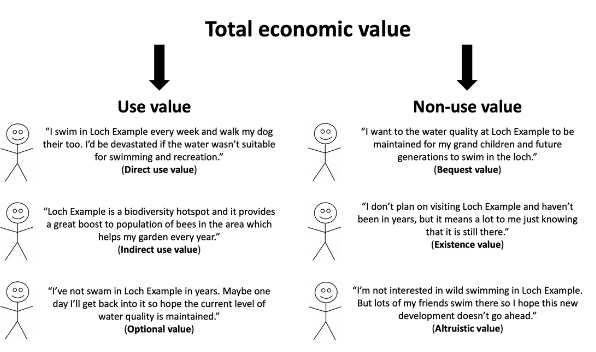
Trying to value the invaluable: A case study of wild swimming at Loch Example


Michael: Hey Katie, how are you? Have you heard the news? A new development has been planned on the banks of Loch Example. Apparently, chemicals will be flowing straight into the loch and wild swimming will no longer be safe. The community council are preparing an objection, but we are finding it really hard to convey the importance of Loch Example. I know you have done some environmental economics stuff before, can you help us out?
Katie: Hey, that’s terrible news but I am happy to help. Yes I’m still doing the environmental economics stuff - I’ll start from the top. Valuing the natural environment and the services (you might see some people refer to these as ecosystem services) that it offers is challenging and valuing water can be particularly tricky given its unique physical properties. Ultimately, you really want to know the total economic value of Loch Example and this is made up of the various ecosystem services that it offers. Some of these are quite easy. For instance, you could find out how changes to water quality as a result of the new development will effect the fish stocks in Loch Example. You could then estimate the economic cost of this change in fish stock relatively straightforwardly, as the value of fish can be easily attained. The challenge that you face is that many of the services that Loch Example offers are not traded in traditional markets and generate ‘non-market’ benefits. You can’t go into a shop and purchase one of your wild swims, but clearly this still have value!
Michael: Thanks for this Katie! So how do we get a better understating of these non-market values? Is it even possible?
Katie: Yes, it’s possible. Economists have been working on this problem for decades and methods used to estimate non-market values are quite commonly used in environmental decision making. These can be categorised as stated preference and revealed preference methods. For revealed preference approaches you need to interpret people’s choices and behaviour in real-life markets and estimate their value of Loch Example accordingly. If you created a short survey for all wild swimmers at Loch Example and asked how often they visit the loch, how far they travel, how long it takes them to travel and what mode of transport they use, you can begin to understand the economic expense that wild swimmers are willing to spend to swim at the loch. This starts to paint a picture of the non-market value.
Michael: Brilliant, but what about the people who don’t use the loch? I think people value Loch Example for many reasons, even if they don’t use it regularly.
Katie: Good question, this is where stated preference methods can be used, these are a little trickier. Basically, stated preference methods rely on people’s behaviour and choices within a hypothetical market. These methods are really useful for understanding the economic cost of a policy that hasn’t actually happened yet. In your case, you will need a survey explaining the potential changes to Loch Example and an opportunity for local residents to contribute financially to avoid these changes if they wish to. A pretty standard approach is to ask how much each individual is willing to pay (usually via increased local tax) to ensure the new development does not take place, water quality does not decrease and wild swimming can continue. Make sure that your survey is well researched and believable and it is crucial that your respondents provide the true amount they would be willing to pay. It’s also useful to ask some questions about their background, income, age and usage of Loch Example. This will make the process of generating an average value a little easier.
Michael: Thanks. We will get started on this ASAP. So once what have generated economic values from our surveys, what do we do next?
Katie: Once you have estimated the economic value of Lake Example and all the services that it offers you should share these with the community council and include these in your planning objection. Your planning objection will be strengthened significantly by using established techniques to demonstrate the economic benefits of protecting Loch Example. But remember, we have only chatted about a handful of the services offered by the loch, you really want to know the total economic value so read up on some of the other benefits Loch Example offers and ask around (I’ve attached some example). Good Luck!!!
Craig McDougall, University of Stirling
